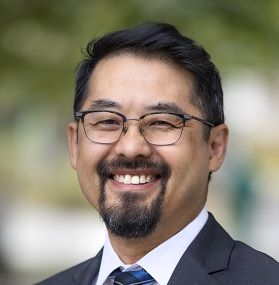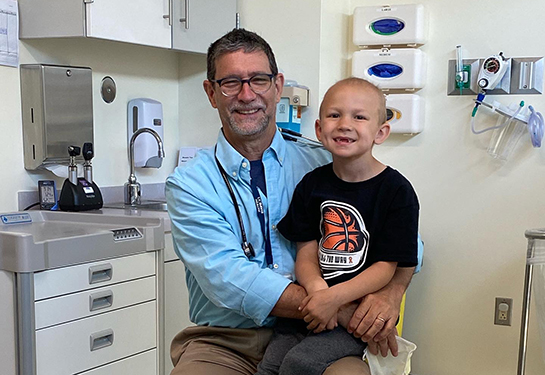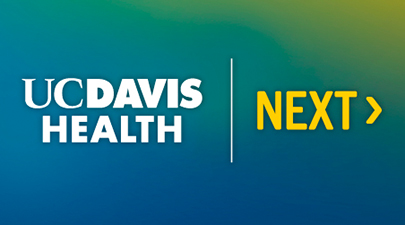Anchor Institution Mission: Delivering community momentum in first 5 years
Defined as the product of mass and velocity, “momentum” is derived from physics. It also describes UC Davis Health’s Anchor Institution Mission, which has delivered significant community momentum already in its first five years of existence.
From increases in local hiring and talent development to boosts in health equity, support for local businesses, and community engagements, “AIM,” as it is also known, serves as an inflection point in the history of UC Davis Health and exemplifies a thoughtful institutional adaption to forces shaping the Sacramento community and health care landscape.
Launched on Feb. 24, 2020, by the Office for Health Equity, Diversity and Inclusion and based on similar initiatives and research across the country, UC Davis Health’s Anchor Institution Mission is focused on economically distressed communities in the Sacramento region. This initially included 13 zip codes – 95817, 95820, 95824, 95828, 95811, 95814, 95815, 95822, 95823, 95838, 95818, 95832, 95833 – with other zip codes added later on.
Anchor institutions are typically hospitals, universities, and government agencies that leverage their economic power, resources, and relationships to improve the surrounding community’s physical, social and economic health.
This enables us to develop long-term relationships with the intention to tackle complex issues like unemployment and poverty which profoundly impact health – problems that cannot be solved by time-limited projects alone, but through long-term commitments made in partnership between UC Davis Health and our surrounding communities.”—Hendry Ton, associate vice chancellor for Health Equity, Diversity and Inclusion
In the area of AIM’s focus on local staff recruitment, UC Davis Health’s Specialty Staffing and Diversity Services and its partners have organized and participated in more than 50 outreach events in the last year, reaching more than 6,300 community members. And, its Career Chats Initiative has involved 669 chats since August 2022. Their teams have also conducted one-on-one guidance, resume assistance and interview preparations with more than 280 candidates in the past year.
Dreya DeShazier Yin, Diversity and Outreach Analyst, said, “The true heart of our work is the success stories we get to be a part of. For example, one candidate, after a Career Chat with me, joined UC Davis Health and now leads critical work around clinical and financial performance.”
DeShazier Yin added, “Reflecting on their experience, they told me that ‘our culture is consistently welcoming, inclusive, and team-based. I love being here and am very grateful.’”
She noted that another participant who came in seeking job search support was able to receive customized resume advice and encouragement — this person eventually accepted a role in UC Davis's admissions office.
“They expressed that the Career Chat provided them with the confidence boost they needed to succeed,” DeShazier Yin said.
‘Engagement, creativity, intentionality’
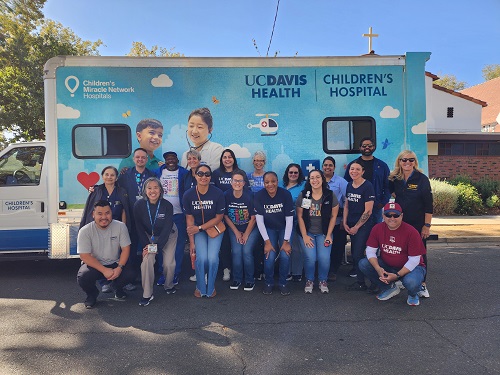
Khoban Kochai, director of the Anchor Institution and Culture/Climate Initiatives at UC Davis Health, said, “I’m most impressed by the overall buy-in from faculty, staff, and leadership to support strategies that improve the health and well-being of our surrounding under-resourced communities.”
Once the connection between health, wealth, and zip codes became clear, Kochai said, “Our employees have shown remarkable engagement, creativity and intentionality in advancing our Anchor Institution Mission.”
She noted that the collective effort has been pivotal in “building trust with our communities and demonstrating that we are not just champions of health equity in principle, but active participants in making it a reality.”
Kochai said AIM has identified three key areas for UC Davis Health to target:
- Developing the local workforce, including our own employees.
- Supporting small, locally owned businesses.
- Investing in activities that directly contribute to improving the lives of those living in under-resourced communities.
Hendry Ton, associate vice chancellor for Health Equity, Diversity, and Inclusion, described how AIM has transformed the perspective of UC Davis Health in understanding its role in the local community, not just as individuals or teams, but as an organization as a whole.
“This enables us to develop long-term relationships with the intention to tackle complex issues like unemployment and poverty which profoundly impact health – problems that cannot be solved by time-limited projects alone, but through long-term commitments made in partnership between UC Davis Health and our surrounding communities,” Ton said.
Local workforce cultivation
Through its Anchor Institution Mission, UC Davis Health has committed to strategically leveraging its economic and human resources to advance the economic vitality of our surrounding under-resourced communities. In the fiscal year 2024, the health system achieved a 20% local hiring rate, an increase from 14% when AIM first started in fiscal year 2020.
This work is essential to advancing health equity and ensuring our local communities thrive.”—Lyndon Huling, executive director, for Talent Acquisition and Compensation Services
This progress aligns with the organization's “local hire” strategy, as research shows that social determinants of health – such as access to quality education, fair-paying jobs and safe living environments – account for about 40% of health outcomes.
Lyndon Huling, executive director, for Talent Acquisition and Compensation Services, said, “Through AIM, UC Davis Health has made significant strides in recruiting diverse and local talent by fostering deep connections with our community.”
Over the past five years, Huling said, the health system has expanded outreach to underserved communities, collaborated with organizations to provide tailored guidance to applicants, and launched innovative pathway programs that create new opportunities for employment and upskilling.
He added, “These efforts, led by our HR Diversity Services team and partners like the Health Equity, Diversity, and Inclusion office, and Aggie Square, demonstrate our unwavering commitment to building a workforce that reflects the patients and community we serve.”
By hiring locally, UC Davis Health enhances is diversity and innovation and strengthen our role as a top employer and trusted healthcare partner, Huling said.
“This work is essential to advancing health equity and ensuring our local communities thrive,” he noted.
Ton added, “Investing in our local workforce also fosters positive relationships between UC Davis and our local communities, enhances our knowledge of local culture, resources, and practices that help to advance our service, education, and research missions as a land grant university, and prevents gentrification and displacement of local residents.”
Support for local, diverse businesses
In April 2024, UC Davis Health hosted its first in-person Small and Diverse Supplier Expo at the Oak Park Community Center, in a neighborhood that is vital to the economy surrounding the Sacramento campus. About 100 suppliers showed up to learn what it takes to sell their goods and services to UC Davis Health and UC Davis.
That month, UC Davis Health reported nearly $62 million in spending with small and diverse-owned suppliers in fiscal year 2023, an increase of 23% from the previous year. Also, local neighborhood spending accounted for more than $17 million. These outcomes represent significant progress toward supporting local business growth, especially in underserved areas.
Annie Reyes-Salgado, the director of Supply Chain & Contracting Services, said in a prior news release that, “Our procurement and contracting team at the medical center has leaned in on this initiative over the last four years.”
She added, “We have made tremendous strides in connecting small and diverse businesses to our key stakeholders, streamlining the new vendor process, educating our internal departments, and helping to level the playing field with large suppliers. With more work to be done, it’s encouraging to not only see overall program growth, but also to take pride in the increased spend right in our own backyard.”
Plans are underway now to hold another expo this spring. A diverse supplier is a business that is at least 51% owned and operated by an individual or group that is part of an underrepresented or underserved group. The goal is to increase local, diverse spending to 25% over the next 5-10 years.
Community engagement
In alignment with its Anchor Institution Mission, UC Davis Health was the presenting sponsor at the “Celebrate Oak Park” event on Aug. 17, 2024. Volunteers from numerous departments participated, including the Office for Health Equity, Diversity and Inclusion, Food and Nutrition Services, the Office for Wellness Education, Volunteer Services, plus Talent Acquisition and Compensation Service's Diversity Services.
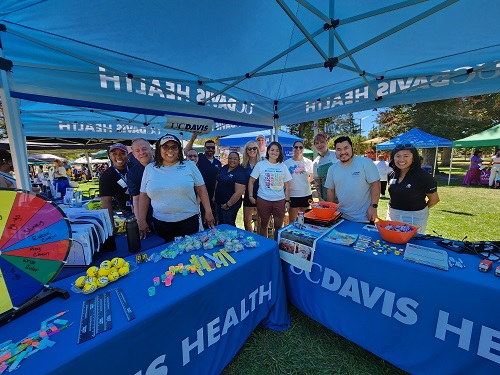
Touyee Thao, Anchor Institution Mission program analyst, said in an Insider story, “UC Davis Health was centrally located at the event, allowing us to engage with over 400 individuals, including families, children, and adults of all ages. This presence helped us build and strengthen relationships with community-based organizations and community members who expressed appreciation for the resources we provided and our significant involvement in the event.”
Also, UC Davis Health has invested funds in local community-based organizations, such as the Oak Park Farmers market, to address job and food insecurity in vulnerable communities. Over 2,000 low-income individuals and more than 500 families benefitted from this program.
In addition – and as part of AIM – UC Davis Health helps support 12 student-run clinics, each developed to support the heath of specific underserved communities in the Sacramento region, particularly within the AIM zip codes.
Local food sourcing
UC Davis Health has cultivated partnerships that extend beyond university walls and into Sacramento’s small business ecosystem. One area is in local food sourcing, which involves sustainability purposes as well. Since arriving in 2017, Head Executive Chef Santana Diaz has transformed the way UC Davis Health invests in local farmers, ranchers, patients, and the community.
“Our food service model is focused on local sourcing, nutrition, and taste. Good food is good medicine. When we reduce unnecessary additives and preservatives, and educate our patients, visitors, and staff, we create a healthier community,” he said in a prior publication.
An example is a collaboration with Ginger Elizabeth Chocolates, a local artisan chocolatier renowned for crafting exquisite, small-batch treats that feature the best of Sacramento’s agricultural bounty. This work – and other local food sourcing efforts – align with AIM’s mission to support local farmers, businesses, patients, and communities.
Looking forward
Kochai said that as the AIM team prepares for its 5-year anniversary its teams are focused on deepening the impact and expanding the reach of the program.
“Our work remains rooted in collaboration and action, and we’re excited to see how we can further support the health and well-being of our communities in the years ahead,” she said. Some key goals include:
- Strengthen community partnerships: Build even more robust collaborations with local organizations to address systemic barriers to health equity and create sustainable change.
- Expand programs: Support innovative initiatives tailored to the unique needs of under-resourced communities and small businesses, informed by data and feedback from internal and external partners.
- Uplift impact: Showcase UC Davis Health as a leader and national model in its AIM work. Implement a comprehensive communication plan to highlight successes and share measurable outcomes of our efforts.
- Reinforce knowledge: Develop practical tools and resources that offer UC Davis Health departments and leaders a clear roadmap for implementing and sustaining AIM strategies effectively.
The other game-changer is the California Tower, which is scheduled to open in 2030 and is also aligned as an Anchor Institution project through the selection of key partners for the project. The tower will include a 14-story hospital facility and 5-story pavilion adjacent to the existing medical center – part of a hospital complex that has served the neighborhoods at this location for 150 years.
In the spirit of the Anchor Institution Mission, it’s envisioned that the $3.75 billion California Tower will enhance the socioeconomic infrastructure of the surrounding neighborhoods through an increase in local jobs, supplier growth, and greater health equity.
For more information: Subscribe to the Anchor Institution Mission newsletter to keep in touch with its activities and click here to view prior issues. Other helpful links, key partners, and processes include:

